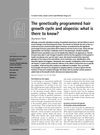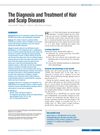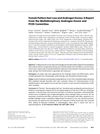TLDR Patient history is key in diagnosing hair loss types.
The document discussed the diagnostic process for patients experiencing hair loss, focusing on differentiating between increased hair shedding, such as diffuse alopecia areata (AA) and telogen effluvium (TE), and progressive hair thinning, like androgenetic alopecia. Dermatologists relied heavily on patient history, including hormonal status, medication use, recent illnesses, surgeries, traumatic experiences, family history, and hair styling practices, to categorize the type of hair loss. While history and examination were crucial in diagnosing most cases, histological examination provided only moderate value.

Advancements in diagnostics, treatments, and technology have improved hair loss detection and restoration, with some types being reversible.
 3 citations
,
June 2006 in “Expert Review of Dermatology”
3 citations
,
June 2006 in “Expert Review of Dermatology” The document concludes that hair loss is complex, affects many people, has limited treatments, and requires more research on its causes and psychological impact.
 37 citations
,
May 2016 in “Deutsches Arzteblatt International”
37 citations
,
May 2016 in “Deutsches Arzteblatt International” Hair loss requires customized treatments based on its various causes and types.
 16 citations
,
June 2008 in “Springer eBooks”
16 citations
,
June 2008 in “Springer eBooks” Over 50% of women over 50 experience hair loss, with minoxidil being the only proven effective treatment.
 49 citations
,
February 2019 in “The Journal of Clinical Endocrinology and Metabolism”
49 citations
,
February 2019 in “The Journal of Clinical Endocrinology and Metabolism” Use "female pattern hair loss" term, assess androgen excess, treat with minoxidil and other medications if needed.





